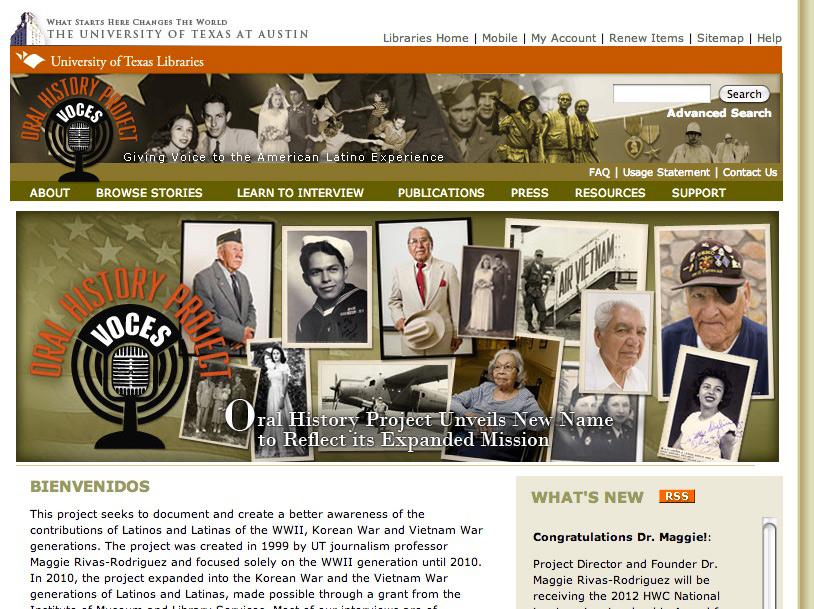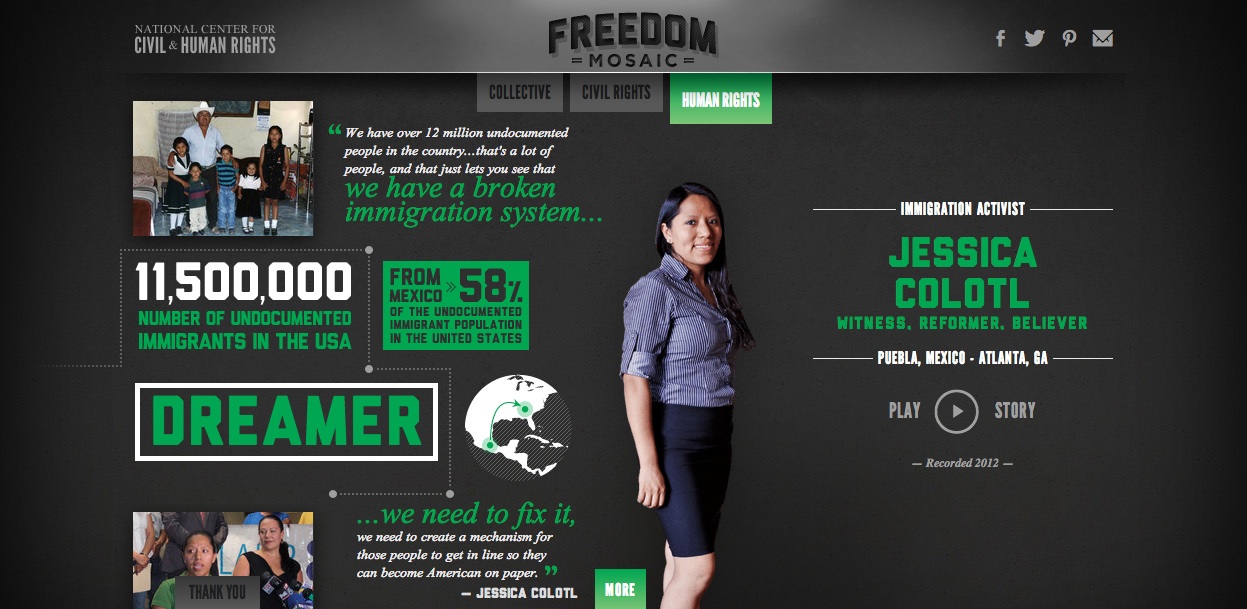By Caitlin Tyler-Richards
In November 2012, a thread appeared on the H-Net Oral history listserv with the enticing subject line “experimental uses of oral history.” Amid assorted student projects and artistic explorations, two projects in particular caught my eye: the VOCES Oral History Project and the Freedom Mosaic. As we work towards our upcoming special issue on Oral History in the Digital Age, I’ve been mulling over oral historians negotiate online spaces, and how the Internet and related advancing technologies can inspire, but also challenge the manner in which they share their scholarship. I believe the VOCES Oral History Project and the Freedom Mosaic offer two distinct paths historians may take in carving out online space, and raise an interesting issue regarding content versus aesthetics.
 Based out of the University of Texas at Austin, the VOCES Oral History Project (previously the US Latino & Latina WWII Oral History Project) launched the spring of 1999 in response to the dearth of Latin@s experiences in WWII scholarship. Since its inception, the project has conducted over 500 interviews, which have spawned a variety of media, from mini-documentaries to the play Voices of Valor by James E. Garcia. My personal favorite is the Narratives Newspaper (1999-2004), a bi-annually printed collection of stories written by journalism students, based on interviews conducted with the WWII veterans. Thanks to a grant from the Institute for Museum and Library Services, in 2009 VOCES expanded its project to include the Vietnam and Korean Wars — hence the name change.
Based out of the University of Texas at Austin, the VOCES Oral History Project (previously the US Latino & Latina WWII Oral History Project) launched the spring of 1999 in response to the dearth of Latin@s experiences in WWII scholarship. Since its inception, the project has conducted over 500 interviews, which have spawned a variety of media, from mini-documentaries to the play Voices of Valor by James E. Garcia. My personal favorite is the Narratives Newspaper (1999-2004), a bi-annually printed collection of stories written by journalism students, based on interviews conducted with the WWII veterans. Thanks to a grant from the Institute for Museum and Library Services, in 2009 VOCES expanded its project to include the Vietnam and Korean Wars — hence the name change.
VOCES does not have the most technologically innovative or visually attractive website; it relies on text and links much more than contemporary web design generally allows. However, it still serves as a strong, online base for the project, allowing the staff to maintain and occasionally expand the project, and facilitates greater access to the public. For instance, VOCES has transferred the Narratives Newspaper stories into an indexed, online archive, one which they continue to populate with new reports featuring personal photos. The website also helps to sustain the project by inviting the public to participate, encouraging them to sign up for VOCES’ volunteer database or conduct their own interviews. They continue to offer a print subscription to a biannual Narratives Newsletter, which speaks to the manner in which they straddle the line between print and digital. It’s understandable given their audience (i.e. war veterans), yet I wonder if it also hinders a full transition into the digital realm.
The second project that intrigued me was the Freedom Mosaic, a collaboration between the National Center for Civil and Human Rights, CNN and the Ford Foundation to share “individual stories that changed history” from major civil and human rights movements. The Freedom Mosaic is a professionally-designed “microsite” that opens with an attractive, interactive interface made up interviewees’ pictures, which viewers can click on to access multimedia profiles of civil and human rights participants. Each profile includes something like a player’s card for the interviewee on the left side of the page — imagine a title like, “Visionary”, a full body picture, an inspiring quote, personal photos, and perhaps a map. On the right side, viewers can click “Play Story” to watch a mini-documentary on the subject, including interview clips. Viewers can also click the tab “More” at the bottom to bring up a brief text biography, additional interviews and interview transcripts.
 The Freedom Mosaic is not a standard oral history project. According to Dr. Clifford Kuhn, who served as the consulting historian and interviewer, and introduced the site to H-NetOralHist listserv, “The idea was to develop a dynamic web site that departed from many of the archivally-oriented civil rights-themes web sites, in an attempt to especially appeal to younger users, roughly 15-30 years old.” On one hand, I greatly approve of beautifully designed projects that trick the innocent Internet explorer into learning something — and I think the Freedom Mosaic could succeed. However, I’m bothered by the site’s dearth of… history. Especially when sharing contemporary stories like that of immigration activist Jessica Colotl, I would have liked a bit more background on immigration in the United States than her brief bio provides.
The Freedom Mosaic is not a standard oral history project. According to Dr. Clifford Kuhn, who served as the consulting historian and interviewer, and introduced the site to H-NetOralHist listserv, “The idea was to develop a dynamic web site that departed from many of the archivally-oriented civil rights-themes web sites, in an attempt to especially appeal to younger users, roughly 15-30 years old.” On one hand, I greatly approve of beautifully designed projects that trick the innocent Internet explorer into learning something — and I think the Freedom Mosaic could succeed. However, I’m bothered by the site’s dearth of… history. Especially when sharing contemporary stories like that of immigration activist Jessica Colotl, I would have liked a bit more background on immigration in the United States than her brief bio provides.
VOCES and the Freedom Mosaic are excellent examples of how historians may establish a space online, amid the cat memes and indie movie blogs, for academic research. While I have my concerns, I believe both sites succeed in fulfilling their projects’ respective goals, whether that be archiving or eye-catching. However, I would ask you, lovely readers: Is there a template between VOCES’ text heavy archive and the Freedom Mosaic’s dazzling pentagons that might better serve in sharing oral history? What would a rubric for “successful oral history sites” look like? Or should every site be tailor fit to each project?
To the comments! The more you share, the better the eventual OHR website will look.
Caitlin Tyler-Richards is the editorial/ media assistant at the Oral History Review. When not sharing profound witticisms at @OralHistReview, Caitlin pursues a PhD in African History at the University of Wisconsin-Madison. Her research revolves around the intersection of West African history, literature and identity construction, as well as a fledgling interest in digital humanities. Before coming to Madison, Caitlin worked for the Lannan Center for Poetics and Social Practice at Georgetown University.
The Oral History Review, published by the Oral History Association, is the U.S. journal of record for the theory and practice of oral history. Its primary mission is to explore the nature and significance of oral history and advance understanding of the field among scholars, educators, practitioners, and the general public. Follow them on Twitter at @oralhistreview and like them on Facebook to preview the latest from the Review, learn about other oral history projects, connect with oral history centers across the world, and discover topics that you may have thought were even remotely connected to the study of oral history. Keep an eye out for upcoming posts on the OUPblog for addendum to past articles, interviews with scholars in oral history and related fields, and fieldnotes on conferences, workshops, etc.
Subscribe to the OUPblog via email or RSS.
Subscribe to only history articles on the OUPblog via email or RSS.
The post Oral historians and online spaces appeared first on OUPblog.


